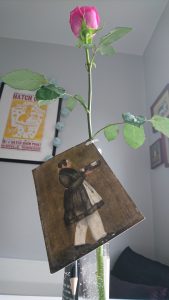I torsdags var det alltså invigning av Upsala, darling på Uppsala konstmuseum. Det blev en stark och fin blandning av tal, poesi och musik, med en trumpetfanfar som avslutning på ceremonin! Men själva konsten, i ett av rummen på konstmuseet, gör sig nog allra bäst när man får vara lite mer själv med den.
På torsdag 31/8 är det dags för nästa programpunkt, ett föredrag/samtal om trygga och queera rum. Den första gemensamma stadsvandringen hålls onsdag 6/9, och på Kulturnatten 9/9 blir det performancekonst med Kolbeinn Karlsson på Uppsala konstmuseum. Hela programmet går att läsa här.

Jag har tyvärr inga foton från invigningsceremonin i torsdags, men här ett foto på rosen och vykortet jag fick, på en målning som föreställer Aron Forss. Aron Forss, som hade ett konditori på Drottninggatan på 1840-talet, finns med i Upsala, darlings karthäfte och kommer att finnas med i min bok.
Karthäftet med queera berättelser och platser finns i webb- och pdf-versioner här, men jag rekommenderar att ta en sväng till konstmuseet för att kolla in skulpturerna och ljudkonsten, och samtidigt plocka upp pappersversionen av kartan.
I slutet av förra veckan fick jag förresten även hem Johan Svedjedals nya Karin Boye-biografi, en halv decimeter tjock och spännande tegelsten att lägga i den allt högre ”att läsa”-högen…
Mitt tal från invigningen av Upsala, darling:
Thank you. So, my name is Petra Marandi Roos, and I have been invited to speak because I’m currently working on a book about the history of Uppsala from an LGBTQ perspective. It feels great to be here with all of you for the opening of “Upsala, darling”. In fact, it’s not only exciting, but also important that something like “Upsala, darling” now exists.
For anyone who is part of the norm, I think it might be harder to notice how people like oneself are visible all the time, in newspapers, on television, in advertisement and in movies, but also in museums, in public art and in history books. For people who belong to a group which is less visible, it’s often more obvious that something’s missing. For me as an LGBTQ person it all started as a gnawing feeling. I was thinking: “Do we not exist? Haven’t we always existed?”. And then: “If we do exist, and in one sense or another always have, why are our stories not told? Are they stories to be ashamed of and hide? Or are our stories not as important to tell?”
I have been interested in history since I was a child. Growing up in a city like Uppsala, I think that happens easily. The city is full of well-known historical sites and buildings, like the castle we are standing in right now. But regardless of how long you or your family have lived here, I think knowledge about the history of your hometown can increase the feeling of belonging. Especially if we seek out, and put forward, more stories of, and perspectives on, the past, instead of telling just one single story over and over again.
To be able to see yourself reflected in history is a form of power. It is significant to be able to walk through Uppsala knowing that someone who was a little bit like yourself also walked in that place fifty or one hundred or two hundred years ago. It strengthens feelings of belonging and connectedness, and makes one feel less lonely. All kinds of people have lived all kinds of lives throughout history. I believe having knowledge of this increases our ability to see the multitude of possibilities in our own lives, here and now, as well as when we dream about the future!


Lämna ett svar